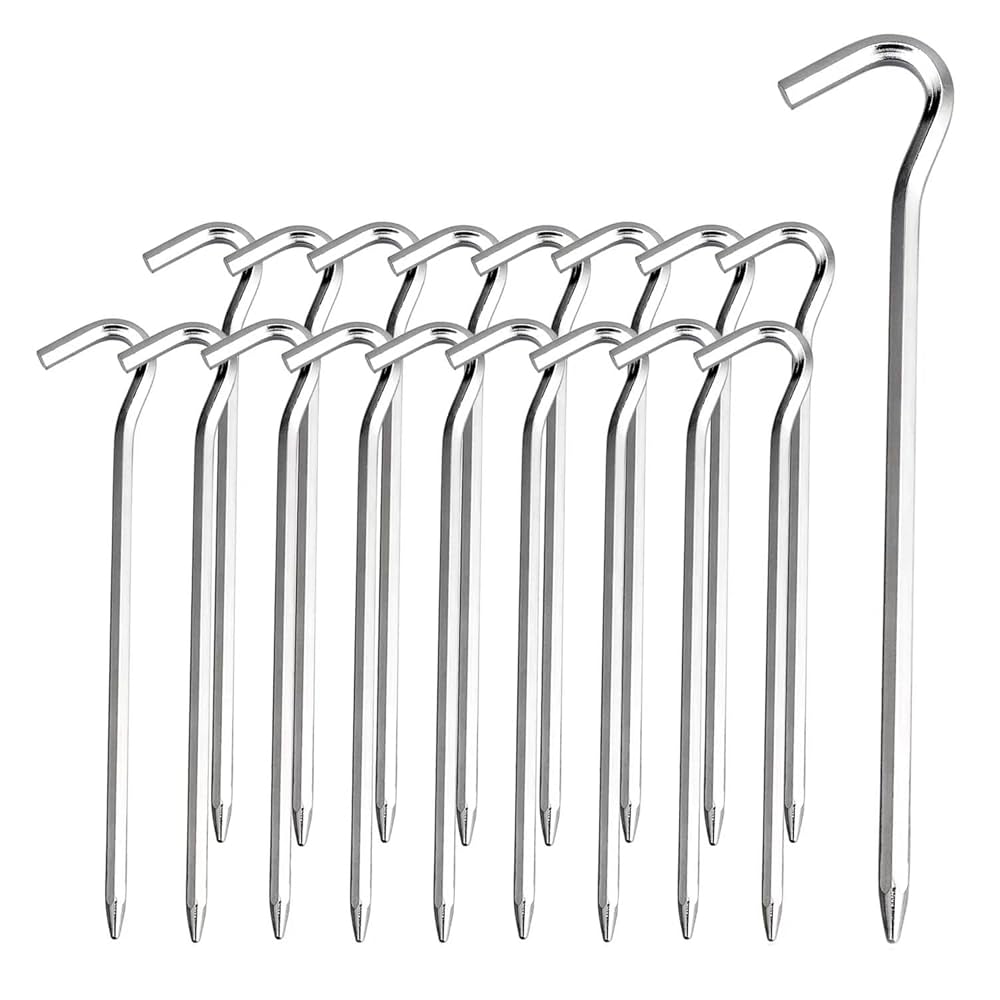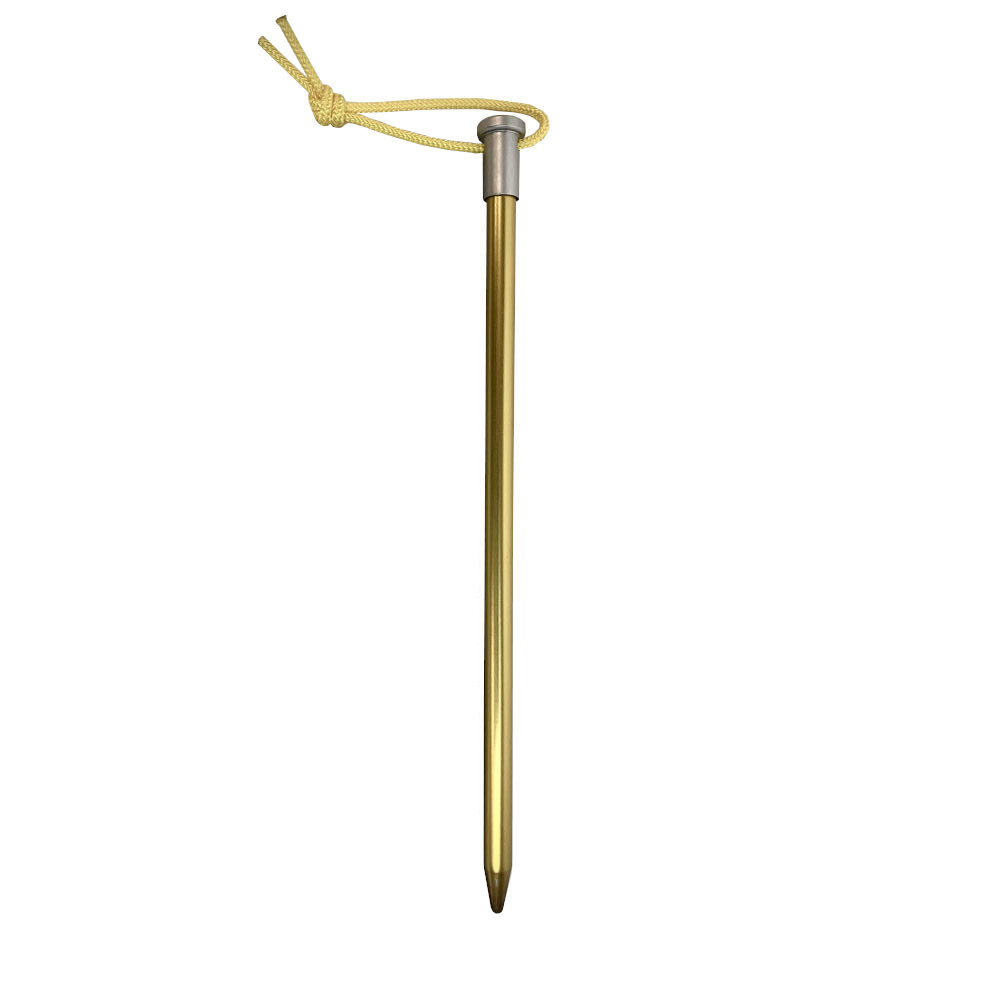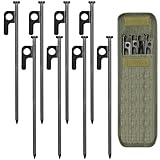This blog post may contain affiliate links. As an Amazon Associate I earn from qualifying purchases.
Imagine this: you’re on a camping trip, the stars are twinkling above, the air is fresh, and the serenity of nature envelops you. But suddenly, a gust of wind threatens to turn your peaceful night into chaos.
Your tent starts to flap, and you’re scrambling to secure it. This is where tent nail stakes become your unsung heroes. You might not think much about these tiny tools, but they play a crucial role in ensuring your tent stays firmly grounded, no matter the weather.
Whether you’re an experienced camper or a beginner setting out for your first adventure, choosing the right tent nail stakes can make all the difference. By understanding why these stakes are essential and how to pick the best ones for your needs, you can enhance your camping experience significantly. Curious about how these simple yet vital items can transform your outdoor adventures? Keep reading, and discover the secrets to a stable, worry-free camping setup that lets you enjoy nature without interruptions.

Top Selling Tent Nail Stakes
Last update on 2025-10-07 / Affiliate links / Images from Amazon Product Advertising API
Also Read: Tent Snow Stakes (Wide): Essential for Winter Camping
Types Of Tent Nail Stakes
Tent nail stakes are essential for camping. They secure your tent firmly to the ground. Choosing the right stake can make or break your camping experience. Different types of tent nail stakes offer various benefits. Understanding these types helps you pick the best one for your needs.
Metal Stakes
Metal stakes are sturdy and durable. They’re often made from steel or aluminum. Steel stakes resist bending and are ideal for hard soil. Aluminum stakes are lighter and great for backpacking. Metal stakes hold up in windy conditions.
Plastic Stakes
Plastic stakes are light and easy to handle. They work well in soft soil. Plastic stakes come in various colors, making them easy to spot. They are less durable than metal stakes. They’re a budget-friendly option for casual campers.
Wooden Stakes
Wooden stakes blend naturally with the environment. They are biodegradable. Wooden stakes are best for sandy or loose soil. They require careful handling to avoid breakage. They’re perfect for eco-conscious campers.
Specialty Stakes
Specialty stakes include snow and sand stakes. Snow stakes are wide and flat, ideal for snowy conditions. Sand stakes have a unique design for beach camping. These stakes cater to specific terrains. Specialty stakes ensure stability in challenging environments.
Choosing The Right Material
When it comes to setting up your tent, the choice of tent nail stakes can make a significant difference in your camping experience. One of the most critical factors to consider is the material of the stakes. Different materials offer various benefits, and understanding these can help you make the right choice for your needs.
Durability And Strength
Durability is crucial when selecting tent nail stakes. You want stakes that can withstand the elements and stay firmly in place. Steel stakes, for example, are known for their robustness and can handle rocky or hard ground with ease. However, they might not be the best choice for all conditions.
On the other hand, aluminum stakes offer a good balance of strength and weight. They are less likely to bend and can be a reliable choice for most camping scenarios. Think about the terrain you usually camp in and choose a material that fits those conditions. Which material will stand the test of time for your adventures?
Weight Considerations
Weight is another essential factor in selecting your tent nail stakes. If you’re backpacking, every ounce counts. Aluminum stakes are lightweight, making them a favorite among backpackers who need to keep their pack as light as possible.
Steel stakes, while heavier, provide extra strength, which might be necessary for more challenging terrains. Titanium stakes are an excellent middle ground, offering both strength and lightness but at a higher cost. Weigh your options and decide what’s worth carrying on your back.
Corrosion Resistance
Corrosion resistance is often overlooked, but it plays a vital role in the longevity of your stakes. Moisture and weather conditions can lead to rust and weaken the stakes over time. Stainless steel stakes offer excellent corrosion resistance, ensuring they last through multiple camping seasons.
Aluminum stakes also resist corrosion well, making them a good choice for wet environments. However, it’s always a good idea to clean and dry your stakes after use to maintain their condition. Have you considered how weather conditions affect your gear?
Choosing the right material for your tent nail stakes is more than just a decision; it’s about enhancing your camping experience and ensuring safety and stability in the great outdoors. Next time you’re planning an adventure, take a moment to consider what your stakes are made of. It could make all the difference in your trip.
Installation Techniques
Setting up a tent can be a rewarding experience, but ensuring it stays secure is crucial for a comfortable camping trip. Tent nail stakes are your trusty companions in this task. Mastering the art of their installation can make all the difference, especially when you’re faced with various ground conditions. Let’s dive into some practical techniques to ensure your tent stays put no matter where you pitch it.
Driving Stakes Into Hard Ground
Hard ground can be a challenge. You might feel like you’re trying to drive a stake into concrete. The key is to use a mallet. Start by positioning the stake at a slight angle, away from the tent. This adds stability. If the ground is particularly stubborn, pour a bit of water on it to soften the surface slightly. Patience is your friend here. A few firm taps with a mallet should do the trick.
Securing In Soft Soil
Soft soil poses the opposite challenge. Stakes can easily wobble or pull out. Your solution? Use longer stakes. They provide more grip. Drive them straight into the ground. For added stability, tie your guy lines at a lower angle. This helps keep the tension right and your tent secure.
Avoiding Rocky Areas
Rocks can be a real headache. They can bend your stakes or prevent proper installation. If possible, scout your campsite in advance. Choose areas with minimal rocks. If unavoidable, position stakes between rocks. This way, they can still anchor your tent without getting damaged.
Each camping trip presents its own set of challenges. Have you ever had to get creative with your tent stakes? Share your experiences in the comments below. Remember, the right technique can save you time and keep your tent secure, allowing you to enjoy the great outdoors with peace of mind.
Maintenance And Care
Proper maintenance ensures tent nail stakes last longer. Clean them after each use. Store in a dry place to prevent rust.
Maintaining and caring for your tent nail stakes is crucial to ensuring they last for many camping trips to come. Proper maintenance not only extends their lifespan but also guarantees that they perform optimally when you need them most. Let’s dive into some practical tips on how to care for your tent nail stakes effectively.
Cleaning And Storage
After a camping trip, take a moment to clean your tent nail stakes. Dirt and grime can corrode metal over time, reducing their effectiveness. Simply rinsing them with water and wiping them dry can prevent rust and other damage. Store your stakes in a dry place to avoid moisture build-up. Consider using a small cloth bag to keep them organized and protected. If you’re like me, finding stakes tangled in the tent bag can be a frustrating start to any camping trip.
Checking For Wear And Tear
Regularly inspect your stakes for any signs of damage. Bent or broken stakes can fail to secure your tent properly, which can be disastrous in bad weather. Run your fingers along the stake to feel for any sharp edges or bends. Replace any stakes that have visible damage. It’s better to invest in new ones than risk your tent collapsing in the middle of the night. Have you ever had a stake snap in rocky soil? It’s a lesson in preparedness you won’t forget.
Replacement Tips
When replacing tent nail stakes, consider the environment you often camp in. For rocky terrain, opt for sturdier stakes made of steel or titanium. For softer ground, aluminum stakes may suffice. Evaluate the length and shape of the stakes for the best hold in different conditions. Longer stakes provide more stability, while spiral designs offer better grip in loose soil. What type of stakes do you swear by on your camping adventures? Your choice can make setting up camp a breeze or a challenge.
Common Mistakes To Avoid
Whether you’re a seasoned camper or a newbie to outdoor adventures, setting up a tent can be a tricky task. Tent nail stakes are essential for keeping your shelter stable and secure. However, common mistakes can lead to a frustrating experience, from loose tents to potential damage. Let’s dive into these pitfalls so you can ensure your next camping trip is smooth sailing.
Improper Placement
One of the most common mistakes is placing stakes in the wrong spots. If you’ve ever found your tent flapping wildly in the wind, you might have fallen into this trap. Stakes should be inserted at a 45-degree angle, pointing away from the tent. This ensures maximum tension and stability.
Think about the ground you’re working with. Hard ground might require a different strategy than soft soil. Are you placing your stakes too close to the tent? This can lead to reduced support and a shaky setup.
Using The Wrong Stake Type
Not all stakes are created equal. Using the wrong type can compromise your tent’s integrity. For sandy or loose soil, opt for wider stakes that provide better grip. Rocky terrain calls for more durable stakes, like those made from steel.
Consider the weather conditions. Lightweight plastic stakes might be convenient, but they won’t hold up in windy situations. Have you ever found your stakes bent or broken after a storm? This could be a sign you need to upgrade to a sturdier option.
Overtightening Guy Lines
It’s tempting to pull guy lines as tight as possible for a snug fit, but this can backfire. Overtightening can stress your tent fabric and lead to tears. A taut line is ideal, but it should have a little give to accommodate movement.
Have you noticed tension lines creating awkward angles or causing your tent to warp? This might be due to excessive force. Consider a gentle pull and observe how your tent responds. Can you adjust the tension for better results?
By avoiding these common mistakes, you can ensure a more enjoyable camping experience. What challenges have you faced with tent nail stakes? Share your insights and join the conversation!
Innovative Stake Designs
Camping gear has seen many changes over the years. Tent nail stakes are no exception. They have evolved with new designs and features. These changes make camping easier and more enjoyable. Let’s explore some innovative designs that stand out today.
Lightweight Options
Weight matters a lot in camping. Carrying heavy gear can be a burden. Lightweight tent stakes offer a solution. They use materials like aluminum and carbon fiber. These materials keep them strong but light. Campers can carry them with ease and without any extra strain.
Multi-functional Stakes
Some stakes do more than just hold tents. Multi-functional stakes bring added benefits. They can also serve as bottle openers or tools. Such versatility makes them a favorite among campers. They save space and reduce the need for extra gear.
Advanced Materials
New materials enhance stake performance. Titanium and other alloys are now common. These materials resist bending and breaking. They also last longer in tough conditions. Campers can rely on these stakes for many trips without worry.
Environmental Considerations
Choosing the right tent nail stakes involves more than just durability and efficiency. Environmental considerations play a crucial role in preserving nature’s beauty. Using eco-friendly materials and techniques ensures camping remains sustainable. This approach protects both the campsite and the surrounding ecosystem.
Leave No Trace Principles
Leave No Trace principles guide campers in minimizing their environmental impact. Avoid damaging vegetation and wildlife habitats with careful stake placement. Use existing trails and campsites whenever possible. This practice helps maintain the natural landscape for future visitors.
Eco-friendly Materials
Eco-friendly materials offer sustainable choices for tent nail stakes. Bamboo and recycled metals are popular options. These materials reduce waste and promote environmental health. They also provide durability without harming the ecosystem.
Minimal Impact Techniques
Minimal impact techniques emphasize reducing disturbances during setup. Choose locations with soft soil to avoid damaging roots. Use stakes designed for easy removal to prevent soil disruption. This method supports soil health and preserves the campsite’s natural integrity.
Practical Tips For Campers
Tent nail stakes are essential for securing your tent. They ensure stability, even in windy conditions. Choose sturdy stakes for a firm grip in various terrains. Always pack extra stakes for emergencies.
When you’re planning a camping trip, the little details make all the difference. Tent nail stakes might not be the first thing on your packing list, but they’re essential for a secure setup. Without them, even a gentle breeze can turn your cozy shelter into chaos. Here are some practical tips that can elevate your camping experience from good to great. Whether you’re a seasoned camper or a newbie, these insights will help you keep your tent firmly anchored.
Packing And Transport
Your tent nail stakes need to be easy to carry and accessible. Consider using a small pouch or bag that can be clipped onto your backpack. This keeps them organized and prevents loss. A plastic container can also be a great option to protect them from damage during transport. Remember, having them buried at the bottom of your bag can lead to delays and frustration when setting up camp.
Adapting To Weather Conditions
Weather can be unpredictable, and your stakes need to handle whatever nature throws at them. If strong winds are in the forecast, opt for longer stakes or those with deeper grooves for better grip in the ground. Rainy conditions can soften the soil, affecting your tent’s stability. In such cases, angle the stakes downward to create more resistance. Have you ever struggled with a tent flapping wildly in the wind? Choosing the right stake can prevent that headache.
Choosing The Right Size
Tent nail stakes come in various sizes, and selecting the right one is crucial. If you’re camping in sandy soil, longer stakes will provide better anchorage. In contrast, rocky terrains might require shorter, thicker stakes to withstand pressure. Consider the size of your tent too. Larger tents demand sturdier stakes to support the additional weight and surface area. It’s a simple adjustment that can save you from potential disasters. Are you using stakes that match your camping environment? Equipped with these practical tips, you can ensure your tent remains secure throughout your adventure. Embrace the elements with confidence, knowing your setup is solid.
Frequently Asked Questions
What Can I Use Instead Of Tent Stakes?
Use rocks, sticks, or sandbags to secure your tent. Paracord or guy lines can also provide stability.
What Are The Best Tent Stakes?
The best tent stakes are lightweight aluminum or titanium options. Choose stakes with strong holding power for various terrains. Brands like MSR Groundhog and Vargo Titanium offer durability and reliability. Ensure they have good visibility to avoid tripping.
Should Tent Stakes Be Straight Or Angled?
Tent stakes should be angled for better stability. Angling them increases grip and holds the tent securely. Insert stakes at a 45-degree angle, pointing away from the tent. This method prevents the stakes from pulling out easily, ensuring your tent stays anchored in windy conditions.
Does Tsa Allow Tent Stakes?
Yes, TSA allows tent stakes in checked luggage. Carry-on bags cannot contain tent stakes due to security regulations. Check the TSA website for updates.
Conclusion
Tent nail stakes are essential for secure camping. They keep your tent stable. Choosing the right stakes can make your trip enjoyable. Different materials and designs suit various terrains. Always check your tent’s requirements before buying. Proper stakes save you from weather surprises.
They also prevent unexpected collapses. Next time you camp, pack quality stakes. A small investment ensures safety and comfort. Enjoy nature without worries. Happy camping!












